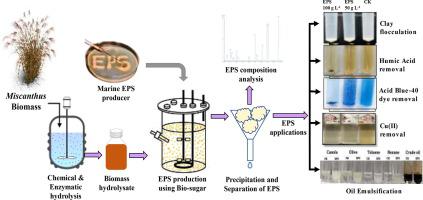Bioresource Technology ( IF 11.4 ) Pub Date : 2022-06-16 , DOI: 10.1016/j.biortech.2022.127499 Ranjit Gurav 1 , Shashi Kant Bhatia 1 , Tae-Rim Choi 1 , Do Hyun Cho 1 , Byung Chan Kim 1 , Su Hyun Kim 1 , Hee Ju Jung 1 , Hyun Joong Kim 1 , Jong-Min Jeon 2 , Jeong-Jun Yoon 2 , Jeonghee Yun 3 , Yung-Hun Yang 1

|
The present study deals with the utilization of lignocellulosic hydrolysate-based carbon source for exopolysaccharide (EPS) production using newly reported marine Echinicola sediminis BBL-M-12. This bacterium produced 7.56 g L–1 and 5.32 g L–1 of EPS on supplementing 30 g L–1 glucose and 10 g L–1 xylose as the sole carbon source, respectively. Whereas on feeding Miscanthus hydrolysate (MCH) with glucose content adjusting to 20 g L–1, E. sediminis BBL-M-12 produced 6.18 g L–1 of EPS. The inhibitors study showed bacterium could tolerate higher concentrations of fermentation inhibitors include furfural (0.05%), 5-hydroxymethylfurfural (0.1%), vanillin (0.1%) and acetate (0.5%). Moreover, the EPS composition was greatly altered with the type and concentration of carbon source supplied, although β-D-Glucopyranose, β-D-Galactopyranose, and β-D-Xylopyranose were the dominant monomers detected. Interestingly, E. sediminis BBL-M-12 EPS revealed excellent environmental applications like clay flocculation, oil emulsification, and removal of humic acid, textile dye, and heavy metal from the aqueous phase.
中文翻译:

用于海洋胞外多糖生产的木质纤维素水解物生物精炼厂及其在环境净化中的应用
本研究涉及利用新报道的海洋Echinicola sediminis BBL-M-12 使用基于木质纤维素水解物的碳源生产胞外多糖 (EPS)。该细菌在补充 30 g L -1葡萄糖和 10 g L -1木糖作为唯一碳源时分别产生 7.56 g L -1和 5.32 g L -1的 EPS。饲喂葡萄糖含量调整为 20 g L –1的芒草水解物 (MCH) 时,E. sediminis BBL-M-12 产生 6.18 g L –1每股收益。抑制剂研究表明,细菌可以耐受更高浓度的发酵抑制剂,包括糠醛(0.05%)、5-羟甲基糠醛(0.1%)、香草醛(0.1%)和醋酸盐(0.5%)。此外,尽管 β-D-吡喃葡萄糖、β-D-吡喃半乳糖和 β-D-吡喃木糖是检测到的主要单体,但 EPS 组成随所提供碳源的类型和浓度而发生很大变化。有趣的是,E. sediminis BBL-M-12 EPS 揭示了出色的环境应用,例如粘土絮凝、油乳化以及从水相中去除腐植酸、纺织染料和重金属。

























 京公网安备 11010802027423号
京公网安备 11010802027423号